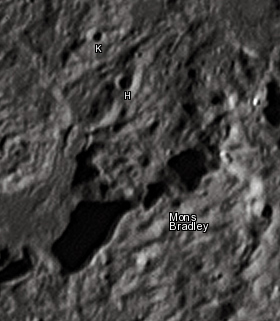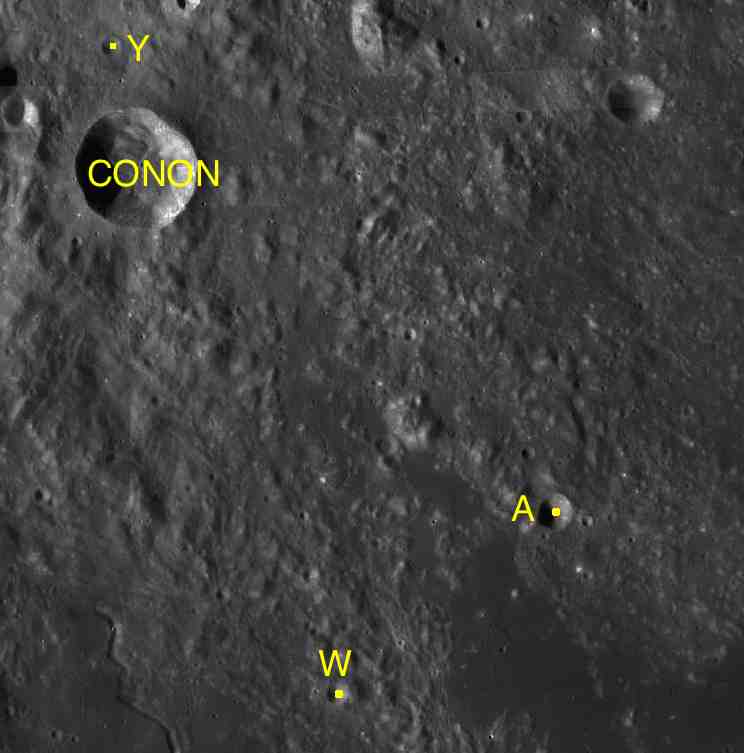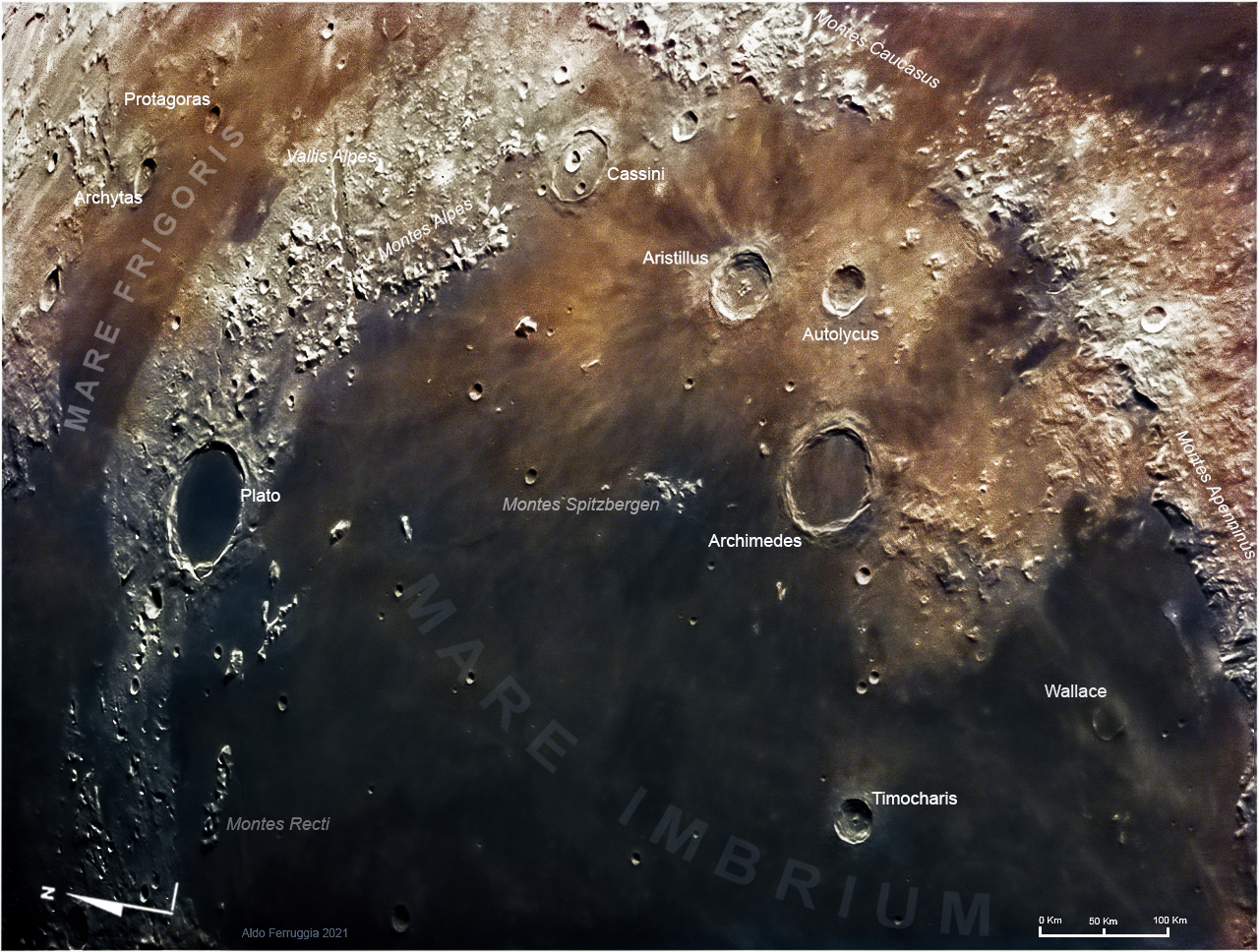|
Mons Bradley
Mons Bradley is a lunar mountain massif in the Montes Apenninus range, along the eastern edge of the Mare Imbrium. It is located to the west of the crater Conon. To the west of this peak is the Rima Bradley rille. (See below.) The selenographic coordinates of this peak are . It has a maximum diameter of 30 km across the base, and rises to a height of about 4.2 km. It is named after the English astronomer James Bradley (1692–1762). Rima Bradley This is a graben-type rille located in the southeastern part of the Mare Imbrium, near the Montes Apenninus range. To the northwest is the prominent crater Archimedes. This rille follows a course to the southwest, starting at the Palus Putredinis, and cutting through a hummocky region. To the east of the northern end of this rille is Rima Hadley and the landing site of the Apollo 15 mission. This feature is centered at selenographic coordinates , and it has a maximum diameter of 161 km. The rille was named for the ne ... [...More Info...] [...Related Items...] OR: [Wikipedia] [Google] [Baidu] |
Conon (crater)
Conon is a small but prominent lunar impact crater that lies in the eastern foothills of the Montes Apenninus mountain range. The crater is named for the Greek astronomer Conon of Samos ( 250 BCE). Just to the west of Conon is the long mountainous ridge Mons Bradley. The nearest craters possessing an eponym are Galen, about to the east, and Aratus, about the same distance to the northeast. Description The edge of Conon's rim is sharply defined and has not received significant erosion from later impacts. The inner wall is somewhat variable in width, and the interior floor forms an irregular oval shape. This irregularity may be due to the rough and uneven surface on which the crater was formed. The floor is rough, but lacks a central prominence of note. To the south, in the Sinus Fidei, is a sinuous rille that follows a course to the south-southeast. This rille is designated Rima Conon, and is named after this crater. Satellite craters By convention these features are ident ... [...More Info...] [...Related Items...] OR: [Wikipedia] [Google] [Baidu] |
Archimedes (crater)
Archimedes is a large lunar impact crater on the eastern edges of the Mare Imbrium. Its diameter is 81 km. Description The diameter of Archimedes is the largest of any crater on the Mare Imbrium. The rim has a significant outer rampart brightened with ejecta and the upper portion of a terraced inner wall, but lacks the ray system associated with younger craters. A triangular promontory extends 30 kilometers from the southeast of the rim. The interior of the crater lacks a central peak, and is flooded with lava. It is devoid of significant raised features, although there are a few tiny meteor craters near the rim. Scattered wisps of bright ray material lie across the floor, most likely deposited by the impact that created Autolycus. Surroundings To the south of Archimedes extends the Montes Archimedes, a mountainous region. On the southeastern rim is the Palus Putredinis, a lava-flooded plain containing a system of rilles named the Rimae Archimedes, which extends ove ... [...More Info...] [...Related Items...] OR: [Wikipedia] [Google] [Baidu] |
Jonathan's Space Report
''Jonathan's Space Report'' (JSR) is a newsletter about the Space Age, hosted at Jonathan's Space Page. It is written by Jonathan McDowell, a Center for Astrophysics Harvard & Smithsonian astrophysicist. It is updated as McDowell's schedule permits, but he tries to publish two issues each month. Originally the website was hosted on a Harvard University account, but was moved in late 2003 to a dedicated domain. Started in 1989, the newsletter reports on recent space launches, International Space Station activities and space craft developments. McDowell's report occasionally corrects NASA's official web sites, or provides additional data on classified launches that aren't available elsewhere. Associated projects on the JSR web site are: * A catalog of all known geosynchronous satellites and their current positions * A listing of satellite launch attempts * A cross-reference between catalog number and international designation of artificial satellites McDowell has long campaig ... [...More Info...] [...Related Items...] OR: [Wikipedia] [Google] [Baidu] |
Cambridge University Press
Cambridge University Press is the university press of the University of Cambridge. Granted letters patent by Henry VIII of England, King Henry VIII in 1534, it is the oldest university press in the world. It is also the King's Printer. Cambridge University Press is a department of the University of Cambridge and is both an academic and educational publisher. It became part of Cambridge University Press & Assessment, following a merger with Cambridge Assessment in 2021. With a global sales presence, publishing hubs, and offices in more than 40 Country, countries, it publishes over 50,000 titles by authors from over 100 countries. Its publishing includes more than 380 academic journals, monographs, reference works, school and university textbooks, and English language teaching and learning publications. It also publishes Bibles, runs a bookshop in Cambridge, sells through Amazon, and has a conference venues business in Cambridge at the Pitt Building and the Sir Geoffrey Cass Spo ... [...More Info...] [...Related Items...] OR: [Wikipedia] [Google] [Baidu] |
List Of Mountains On The Moon By Height
The is a list of mountains on the Moon, arranged by relative height in kilometres. More than four kilometres * Mons Huygens - 5.5 km * Mons Hadley - 4.5 km * Mons Bradley - 4.3 km 3-4 kilometres * Mons Penck - 4.0 km * Mons Hadley Delta - 3.9 km * Mons Blanc - 3.8 km * Mons Wolff - 3.8 km *Mons Ampère - 3.3 km 2-3 kilometres *Mons Pico - 2.4 km *Mons Piton - 2.1 km * Mons Vitruvius - 2.3 km 1-2 kilometres * Mons La Hire - 1.5 km * Mons Vinogradov - 1.4 km * Mons Maraldi - 1.3 km * Mons Rümker - 1.1 km Less than one kilometre * Mons Gruithuisen Gamma - 0.9 km See also {{Portal, Solar System * List of mountains on the Moon * Boot Hill Boot Hill, or Boothill, is the given name of many cemeteries, chiefly in the Western United States. During the 19th and early 20th century it was a common name for the burial grounds of gunfighters, or those who " died with their boots on" (i. ... * Duke ... [...More Info...] [...Related Items...] OR: [Wikipedia] [Google] [Baidu] |
English Language
English is a West Germanic language of the Indo-European language family, with its earliest forms spoken by the inhabitants of early medieval England. It is named after the Angles, one of the ancient Germanic peoples that migrated to the island of Great Britain. Existing on a dialect continuum with Scots, and then closest related to the Low Saxon and Frisian languages, English is genealogically West Germanic. However, its vocabulary is also distinctively influenced by dialects of France (about 29% of Modern English words) and Latin (also about 29%), plus some grammar and a small amount of core vocabulary influenced by Old Norse (a North Germanic language). Speakers of English are called Anglophones. The earliest forms of English, collectively known as Old English, evolved from a group of West Germanic ( Ingvaeonic) dialects brought to Great Britain by Anglo-Saxon settlers in the 5th century and further mutated by Norse-speaking Viking settlers starting in ... [...More Info...] [...Related Items...] OR: [Wikipedia] [Google] [Baidu] |
Irish Language
Irish (an Caighdeán Oifigiúil, Standard Irish: ), also known as Gaelic, is a Goidelic languages, Goidelic language of the Insular Celtic branch of the Celtic language family, which is a part of the Indo-European languages, Indo-European language family. Irish is indigenous language, indigenous to the Ireland, island of Ireland and was the population's first language until the 19th century, when English (language), English gradually became Linguistic imperialism, dominant, particularly in the last decades of the century. Irish is still spoken as a first language in a small number of areas of certain counties such as County Cork, Cork, County Donegal, Donegal, County Galway, Galway, and County Kerry, Kerry, as well as smaller areas of counties County Mayo, Mayo, County Meath, Meath, and County Waterford, Waterford. It is also spoken by a larger group of habitual but non-traditional speakers, mostly in urban areas where the majority are second language, second-language speakers. ... [...More Info...] [...Related Items...] OR: [Wikipedia] [Google] [Baidu] |
Scottish Gaelic Language
Scottish Gaelic ( gd, Gàidhlig ), also known as Scots Gaelic and Gaelic, is a Goidelic language (in the Celtic branch of the Indo-European language family) native to the Gaels of Scotland. As a Goidelic language, Scottish Gaelic, as well as both Irish and Manx, developed out of Old Irish. It became a distinct spoken language sometime in the 13th century in the Middle Irish period, although a common literary language was shared by the Gaels of both Ireland and Scotland until well into the 17th century. Most of modern Scotland was once Gaelic-speaking, as evidenced especially by Gaelic-language place names. In the 2011 census of Scotland, 57,375 people (1.1% of the Scottish population aged over 3 years old) reported being able to speak Gaelic, 1,275 fewer than in 2001. The highest percentages of Gaelic speakers were in the Outer Hebrides. Nevertheless, there is a language revival, and the number of speakers of the language under age 20 did not decrease between the 20 ... [...More Info...] [...Related Items...] OR: [Wikipedia] [Google] [Baidu] |
Hebrew Language
Hebrew (; ; ) is a Northwest Semitic language of the Afroasiatic language family. Historically, it is one of the spoken languages of the Israelites and their longest-surviving descendants, the Jews and Samaritans. It was largely preserved throughout history as the main liturgical language of Judaism (since the Second Temple period) and Samaritanism. Hebrew is the only Canaanite language still spoken today, and serves as the only truly successful example of a dead language that has been revived. It is also one of only two Northwest Semitic languages still in use, with the other being Aramaic. The earliest examples of written Paleo-Hebrew date back to the 10th century BCE. Nearly all of the Hebrew Bible is written in Biblical Hebrew, with much of its present form in the dialect that scholars believe flourished around the 6th century BCE, during the time of the Babylonian captivity. For this reason, Hebrew has been referred to by Jews as ''Lashon Hakodesh'' (, ) since a ... [...More Info...] [...Related Items...] OR: [Wikipedia] [Google] [Baidu] |
Selenographic Coordinate
The selenographic coordinate system is used to refer to locations on the surface of Earth's moon. Any position on the lunar surface can be referenced by specifying two numerical values, which are comparable to the latitude and longitude of Earth. The longitude gives the position east or west of the Moon's prime meridian, which is the line passing from the lunar north pole through the point on the lunar surface directly facing Earth to the lunar south pole. (See also Earth's prime meridian.) This can be thought of as the midpoint of the visible Moon as seen from the Earth. The latitude gives the position north or south of the lunar equator. Both of these coordinates are given in degrees. Astronomers defined the fundamental location in the selenographic coordinate system by the small, bowl-shaped satellite crater ' Mösting A'. The coordinates of this crater are defined as: : Later, the coordinate system has become more precisely defined due to the Lunar Laser Ranging ... [...More Info...] [...Related Items...] OR: [Wikipedia] [Google] [Baidu] |
International Astronomical Union
The International Astronomical Union (IAU; french: link=yes, Union astronomique internationale, UAI) is a nongovernmental organisation with the objective of advancing astronomy in all aspects, including promoting astronomical research, outreach, education, and development through global cooperation. It was founded in 1919 and is based in Paris, France. The IAU is composed of individual members, who include both professional astronomers and junior scientists, and national members, such as professional associations, national societies, or academic institutions. Individual members are organised into divisions, committees, and working groups centered on particular subdisciplines, subjects, or initiatives. As of 2018, the Union had over 13,700 individual members, spanning 90 countries, and 82 national members. Among the key activities of the IAU is serving as a forum for scientific conferences. It sponsors nine annual symposia and holds a triannual General Assembly that sets policy ... [...More Info...] [...Related Items...] OR: [Wikipedia] [Google] [Baidu] |
Apollo 15
Apollo 15 (July 26August 7, 1971) was the ninth crewed mission in the United States' Apollo program and the fourth to land on the Moon. It was the first J mission, with a longer stay on the Moon and a greater focus on science than earlier landings. Apollo 15 saw the first use of the Lunar Roving Vehicle. The mission began on July 26 and ended on August 7, with the lunar surface exploration taking place between July 30 and August 2. Commander David Scott and Lunar Module Pilot James Irwin landed near Hadley Rille and explored the local area using the rover, allowing them to travel further from the lunar module than had been possible on previous missions. They spent 18 hours on the Moon's surface on four extravehicular activities (EVA), and collected of surface material. At the same time, Command Module Pilot Alfred Worden orbited the Moon, operating the sensors in the scientific instrument module (SIM) bay of the service module. This suite of instruments co ... [...More Info...] [...Related Items...] OR: [Wikipedia] [Google] [Baidu] |







